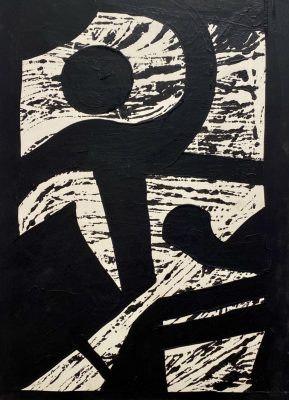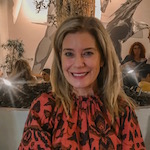JB (James Blain) Blunk was a prolific multidimensional artist based in Northern California, now promoted worldwide by his daughter, curator and local Bay Area resident Mariah Nielson.
Nielson curated “Three Forms: JB Blunk,” an art show at Blunk Space in Point Reyes Station featuring the art of her father that runs through August 8th. The exhibition explores the legacy of the unique Bay Area treasure, JB Blunk, and the magical world he created on the ridge top of Inverness, California. After the exhibit, the gallery will share ongoing exhibitions of historical and contemporary artists, designers, and craftspeople with links to JB’s work and West Marin. The unique hand-built residence by JB Blunk, which he called home until his death in 2002, will soon be open to the public again for tours.
I recently sat down with Mariah Nielson to discuss her recent accomplishments — digitizing and archiving her father’s artwork, publishing two books, and curating pieces into ongoing shows — all completed while raising a family.
JW: Do you feel like you live in a museum surrounded by your father’s art and the wooden home he built by hand?
MN: My father (JB) created a total environment — from the ceramics we eat off of, to the doors we walk through, to the actual structure itself. His home was his masterwork of art. I live in the home JB created for half of the year. The other half of the year, I live in England.
JW: Do you ever wish to introduce other artists and artworks to the Blunk house?
MN: Yes. The home was an artist in residency from 2007- 2011. There wasn’t a formal ask of the artists. However, whoever came to the residency program and spent time in the program left a piece of art specifically for the Blunk home itself. Now, there is a wonderful collection of works from artists and designers who spent time there.
JW: Your father had hoped that the home he built by hand “be full of life and creativity” – how do you carry on his legacy?
MN: The new Blunk Space in Pt. Reyes answers this very question. We hope this will be a public space dedicated to JB’s work, and also host events and exhibitions and sell the book and other products. We are hoping to utilize this space as a center for everything and anything Blunk. And still, we will share the home. When COVID is behind us, we can begin hosting house tours once again. The house tours used to be held monthly, and we would like to get back into that soon.
JW: Given the era and collections of people JB surrounded himself with, I assume every piece of JB’s artworks has a beautiful story behind them. Can you tell me one of your favorite stories?
MN: One special work called “Dreamlock,” now in the collection of Jeff Poe from the international gallery Blum & Poe, is one of my favorite pieces. My father and his long-time assistant Rick Yoshimoto worked on piecing together two huge pieces of redwood — one piece is carved into a seat, and the other is the bench that supports it. JB wanted the two pieces to interlock, and the two of them worked on it for several days. They could not figure out how to connect these two pieces of wood.
So, one night Rick had a dream. In the dream, there was a vision of how these two pieces connect so that in the morning, Rick went back to JB’s studio and said to him, “I had a dream last night, and this is how we do it.” So JB named the sculpture Dreamlock in honor of the dream that Rick had and their unique friendship.
JW: JB often traded his artworks with friends. Are there any particular pieces, memorable trades, and notable exchanges you recall?
MN: Yes, we have a wonderful collection of paintings by JB’s friends. Our collection includes work by artists such as Gordon Onslow Ford, Lee Mullican, Fritz Rauh, John Anderson, who are all artists he spent a great deal of time with over the years and with whom he traded pieces.
JW: JB lived with no separation between art and life. You are now living among his creations in a home he but by hand – do you feel you are living in the same manner as your father did?
MN: I aspire to live the same way — it is an everyday goal.

JW: In one day, your father would work across three to four mediums. What other artist do you think worked or works this way?
MN: Picasso and Noguchi are artists who worked across several different mediums. The art world does not talk about that so much – it is there, and we are all aware of it, but the art market doesn’t support that kind of dexterity or breadth. JB was always pigeonholed as a woodworker, which is why this current show is so exciting. We are presenting his paintings along with his wood stools and the ceramics.
JW: JB had a continuous theme in his creations — back-to-basic, with a Japanese aesthetic. Why do you think his movement continues to be popular?
MN: The JB Blunk book that was just published is a great case study on this – we launched it in May 2020 amid COVID, and initially, we thought the book would not sell well due to the pandemic, but we sold out of the first edition – 3000 copies – in three months. There is a huge interest in JB’s lifestyle – no separation between his art and his home; everything was intertwined and connected with a deep connection to nature. He left mainstream society, a pioneer, to build his own home in Inverness when it was not easy to build a house. So, those decisions and his authentic, spirited, independent vision were what many people are interested in and motivated by today. We all want to go back to the simpler times; we all want to slow down, and it is very difficult to achieve.
JW: Who are some of the artists practicing today that you would consider proteges of JB’s?
MN: JB inspired all the artists who came through the residency program – specifically Max Lamb, a London-based designer; Martino Gamper, originally from Italy but now based in London; and finally Jay Nelson, an artist and woodworker that lives in the Bay Area.
JW: JB Blunk has a following in California, the US, and Japan. Do you think people in other countries are beginning to learn and appreciate his art?
MN: In London, his popularity is growing. I am working with Kate MacGarry, who now represents the estate. We’ve had two shows of JB’s work, so the audience and interest are expanding. In France, friends from Marseille, who are into art and design, just went on a road trip and everywhere they went there was a JB Blunk book. Occasionally, they would meet people — artisans, young craftspeople —who all knew about JB. That feels great. His work will also be in a group show in Athens in September.
JB Blunk Estate / Blunk Space
11101 CA-1 #105
Point Reyes Station, CA 94956
Hours: Th–Sat, 12–5pm, and by appointment

Jennifer Wechsler is Curator for FAULTline Art Shows promoting and exhibiting emerging and established artists in unique spaces. She serves as an Art & Cultural Commissioner for Marin County and serves on boards at UCLA ARTS and The Oxbow School in Napa.